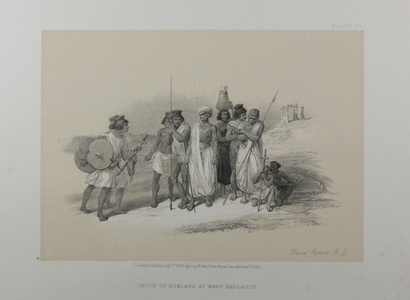| Method | Lithograph with tint stone |
| Artist | after David Roberts |
| Published | London, Published July 1st. 1856, by Day & Son, Gate Street, Lincoln's Inn Fields |
| Dimensions | Image 124 x 173 mm, Sheet 205 x 287 mm |
| Notes |
Plate 171 from Volume 5 of the small format reprint of Roberts' The Holy Land, Syria, Idumea, Arabia, Egypt & Nubia. A view of a group of Nubians standing in the desert near the ruins of the small temple in the village of Qertassi, in the ancient Egyptian region of Nubia. The temple, often referred to as the 'Kiosk of Qertassi,' was built during the Roman era, possibly by the emperor Trajan, and was likely dedicated to the goddess Hathor. The temple was chiefly celebrated for its beautiful slender papyrus columns, though it appears that construction was never completed, and no inscriptions, either dedicatory or of the architect, have been found. The temple, like many other Nubian monuments, was moved in the 1960s to save it from the rising waters of the Aswan Dam, and rebuilt at the site of New Kalabsha. The group of Nubians in Roberts' view are predominantly warriors, though two children and a woman carrying a water jug on her head are also depicted. The warriors are armed with spears, swords and shields, their hair tied up into broad, clipped topknots. Behind them, the ruins of the temple can be be seen on the rise of the cliff. David Roberts RA (24th October 1796 – 25th November 1864) was a Scottish painter. He is especially known for a prolific series of detailed prints of Egypt and the Near East produced during the 1840s from sketches made during long tours of the region (1838-1840). This work, and his large oil paintings of similar subjects, made him a prominent Orientalist painter. He was elected as a Royal Academician in 1841. The firm of Day & Haghe was one of the most prominent lithographic companies of the nineteenth-century. They were also amongst the foremost pioneers in the evolution of chromolithography. The firm was established in 1823 by William Day, but did not trade under the moniker of Day & Haghe until the arrival of Louis Haghe in 1831. In 1838, Day & Haghe were appointed as Lithographers to the Queen. However, and perhaps owing to the fact that there was never a formal partnership between the two, Haghe left the firm in the 1850's to devote himself to watercolour painting. The firm continued as Day & Son under the guidance of William Day the younger (1823 - 1906) but, as a result of a scandal involving Lajos Kossuth, was forced into liquidation in 1867. Vincent Brookes bought the company in the same year, and would produce the caricatures for Gibson Bowles' Vanity Fair magazine, as well as the illustrations for Cassells's Poultry Book, amongst other commissions. Condition: Light foxing to margins, not affecting image. |
| Framing | unmounted |
| Price | £30.00 |
| Stock ID | 39140 |

